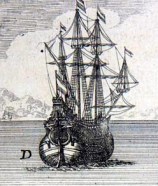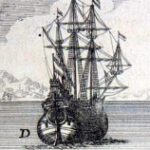Fluit
Ship
Age of Discovery
Quick Facts:
Used primarily for trade, the Fluit was adept at sailing in colder climates and had a large cargo hold.
The fluit was a bulk carrier first developed in Holland, and eventually adopted by other countries including England. The fluit was used for trade in the North Sea and the Atlantic during the early 17th century. Historians believe it was developed from the cog, carrack and small fishing vessels. Merchants were able to build the ship cheaply, and could easily maintain the ship carrying a large amount of cargo with a small crew. The fluit was generally two-masted with a mainsail and topsail that were both square rigged. The mizzenmast carried a lateen sail, and there was usually a spritsail on the bow. The hull was designed like a box, without a forecastle, and had a low, narrow aft castle. The ships ranged from 200 to 500 tons and moved slowly. The amount of cargo they carried offset the cost of this slow ship.
One example of a Fluit is Henry Hudson’s ship, Discovery. The Discovery made many voyages in the effort to discover the Northwest Passage. The first was in 1602 under the command of George Weymouth, although Henry Hudson captained her. The 1602 voyage made it as far as the modern Hudson Strait. In 1610, the Discovery sailed again under Hudson and entered the Hudson Strait. On June 22, 1611, on James Bay, a mutinous crew put Hudson, his son and seven sick crewmen into the Discovery’s shallop and set them adrift. The Discovery returned home to England.
She sailed again in 1612 in a search for Hudson. He was never found.
- Detail of Fluit from “A) Galion, B) Fregate, C) Caraque, D) Flute ou Pinque, E) Est un Beulot ou Bâtiment,” Description de L’Univers, 1683, From The Library at The Mariners’ Museum, G114.M25 rare.


